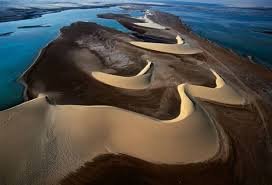Nestled along Qatar’s southeastern border, where golden sands meet the turquoise waters of the Inland Sea, lies Khor Al Adaid—a UNESCO-recognized natural wonder famed for its “singing” dunes. These surreal mountains of sand produce deep, resonant booms that vibrate through the desert, a phenomenon that has mystified travelers, scientists, and Bedouin storytellers for centuries. Unlike ordinary deserts, Khor Al Adaid’s dunes seem alive, emitting eerie harmonies that shift with the wind, from low hums to thunderous roars. This acoustic marvel, combined with the area’s breathtaking isolation, makes it one of the most enigmatic landscapes in the Arabian Peninsula.
The Science Behind the Singing Sands
The dunes of Khor Al Adaid “sing” when dry grains of sand slide down their steep slopes, creating vibrations that amplify through the tightly packed silica particles. Scientists have identified the specific conditions needed for this phenomenon—perfectly spherical grains, low humidity, and slopes between 35 to 40 degrees. However, what makes Khor Al Adaid unique is the sheer volume and musicality of its dunes. Studies reveal that the sand here contains an unusually high concentration of quartz, which enhances resonance. Some researchers even compare the dunes’ low-frequency booms (reaching up to 105 decibels) to the chanting of Tibetan monks or the distant drone of an aircraft.
Bedouin Legends of the Phantom Caravan
For generations, Bedouin tribes have woven tales around the singing sands. One legend speaks of a doomed caravan swallowed by the dunes, their voices forever trapped beneath the grains. Elders claim that on particularly windy nights, the dunes whisper fragments of lost conversations—pleas for water, prayers, and the cries of camels. Another story tells of a jinn (spirit) cursed to wander the dunes, his mournful songs warning travelers not to linger after sunset. These myths were taken seriously enough that early 20th-century explorers, including British adventurer Wilfred Thesiger, noted in their journals how local guides refused to camp near the loudest dunes, fearing supernatural repercussions.
The Lost Oasis and the Hidden Water Channels
Beneath Khor Al Adaid’s surface lies a hydrological mystery—an intricate network of freshwater channels that defy the arid environment. Satellite imaging reveals underground rivers flowing toward the Inland Sea, a remnant of when this region was a lush savanna thousands of years ago. In the 1950s, a British geologist discovered fossilized acacia roots beneath the dunes, suggesting a long-lost oasis. Even today, rare rainfall triggers temporary springs, creating fleeting patches of greenery. Bedouin lore speaks of a “vanishing well” that appears only during full moons, with water said to heal ailments—though no Western explorer has ever confirmed its existence.
UFO Sightings and Military Testing Grounds
The remote, otherworldly landscape of Khor Al Adaid has attracted more than just geologists. Declassified CIA files from the 1960s mention “unexplained luminous phenomena” over the dunes, with pilots reporting strange, hovering lights. In the 1980s, Qatar’s military allegedly used the area to test acoustic detection systems, taking advantage of the dunes’ natural amplification. Rumors persist of a buried research facility studying infrasound—the same type of low-frequency noise the dunes produce—though the government denies such claims. Intriguingly, in 2012, a group of campers recorded a pulsating red light moving in sync with the dunes’ vibrations before vanishing into the night sky.

The Singing Dunes’ Healing Myth
Among local Bedouins, the sands of Khor Al Adaid were historically believed to have therapeutic properties. Traditional healers would bury patients suffering from joint pain in the warm sand, claiming the vibrations loosened stiffness. Some even swore that sleeping near the dunes cured insomnia, attributing it to the rhythmic hums acting as natural lullabies. Modern researchers have found partial truth to these claims—the dunes emit frequencies between 60 to 80 Hz, which some studies suggest can promote relaxation and reduce stress.
The Secret Petroglyphs of Al Mashabiya
Few visitors know that the rocky outcrops bordering Khor Al Adaid hide ancient petroglyphs, some dating back 4,000 years. The most striking carvings depict:
- Human figures with elongated heads, arms raised as if summoning the dunes’ sounds
- A spiral pattern eerily similar to Peru’s Nazca Lines
- A boat design suggesting prehistoric trade links with Mesopotamia
The most enigmatic discovery came in 2018, when archaeologists found a stone slab covered in star maps aligning with celestial events that trigger the dunes’ loudest performances—hinting that ancient peoples may have tracked the singing sands’ patterns.
The Modern-Day Challenge: Conservation vs. Tourism
As Khor Al Adaid gains global attention, Qatar faces a delicate balancing act—protecting the fragile dunes while accommodating growing tourist interest. Off-road vehicles, once allowed to climb the slopes, are now restricted after studies showed they disrupt the sand’s resonant properties. Scientists warn that even footsteps in the wrong areas can silence the dunes for weeks. In response, the government has established guided walking trails and designated “silent zones” where the singing phenomenon is most intense.
The Future of the Singing Sands
Climate change poses the greatest threat to Khor Al Adaid’s acoustic wonder. Rising temperatures and shifting wind patterns could alter the dunes’ grain structure, potentially muting their songs forever. Researchers are now racing to document the exact conditions needed for the phenomenon, hoping to preserve it artificially if necessary. Meanwhile, the Bedouins maintain their ancestral belief—that the dunes will sing only as long as the desert’s ancient spirits permit it.
Khor Al Adaid remains one of nature’s most mesmerizing mysteries—a place where science and legend harmonize as perfectly as the dunes’ haunting melodies. Whether you come for the surreal soundscape, the untouched beauty, or the whispers of forgotten stories, this singing desert promises an experience unlike any other on Earth.
Go to main page


